M88 Recovery Vehicle
| M88 Recovery Vehicle | |
|---|---|
|
An original baseline M88 (Bergepanzer 1) ARV of the German Army on static display at the German Tank Museum outside Munster, Germany. | |
| Type | Armored recovery vehicle |
| Place of origin | United States of America |
| Service history | |
| In service | 1961 – present |
| Used by | See operators |
| Wars | Arab-Israeli conflict, Vietnam War, Persian Gulf War, Kosovo War, Iraq War, Global War on Terrorism, War in Afghanistan |
| Production history | |
| Designer | Bowen McLaughlin York (BMY) |
| Designed | 1959 |
| Manufacturer |
BMY (1961–1994) United Defense & Anniston Army Depot (1994-2005) BAE Systems Land and Armaments (since 2005) |
| Unit cost | US$2,050,000 |
| Produced | 1961 – present |
| Variants | See variants |
| Specifications | |
| Weight |
M88/M88A1: 50.8 t (112,000 lb) M88A2: 63.5 t (140,000 lb) |
| Length | 27.13 ft (8.27 m) |
| Width | 11.25 ft (3.43 m) |
| Height | 10.25 ft (3.12 m) |
| Crew | 3 |
|
| |
| Armor | Hull and cab armored to protect against small-arms fire up to 30mm direct fire weapons |
Main armament | M2 .50 cal heavy MG with 1,300 rounds |
| Engine |
•M88/M88A1: Continental (now L-3 Combat Propulsion Systems) AVDS-1790-2DR V12, air-cooled Twin-turbo diesel engine M88/M88A1: 750 hp (560 kW) M88A2: 1,050 hp (780 kW) |
| Transmission | Twin Disc XT-1410-5A cross-drive (3 speed forward, 1 speed reverse) |
| Suspension | Torsion bar suspension |
| Ground clearance | 17 in (0.43 m) |
Operational range |
M88/M88A1: 450 km (280 mi) M88A2: 322 km (200 mi) |
| Speed |
M88/M88A1: 42 km/h (26 mph) M88A2: 48 km/h (30 mph) |
The M88 Recovery Vehicle is one of the largest armored recovery vehicles (ARV) currently in use by United States Armed Forces. There are currently three variants, the M88, M88A1 and M88A2 HERCULES (Heavy Equipment Recovery Combat Utility Lifting Extraction System). The M88 series has seen action most noticeably in the Vietnam War, the Persian Gulf War, the Iraq War, and the War in Afghanistan, and to a lesser extent during the Kosovo War, where they were deployed to help recover heavy armored vehicles of the Allied ground units. The current M88A2 replacement cost is around US$2,050,000.[1]
History
Design
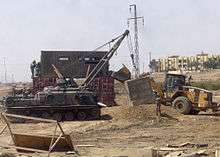
The design of this vehicle was based on the chassis and parts of the automotive component of the M48 Patton and M60 Patton tanks. The original M88 was introduced in 1961, M88A1 in 1977, with the current M88A2 introduced in 1997.[1]
Development
Originally manufactured by Bowen McLaughlin York (later the BMY division of Harsco Corporation) in 1961, the company would later merge with FMC Corp. to form the United Defense Industries in 1994, which was in turn acquired by BAE Systems in 2005 to become BAE Systems Land and Armaments. In February 2008 the company was awarded a $185 million contract modification from the U.S. Army to manufacture 90 Army-configured M88A2s, four United States Marine Corps-configured M88A2s and authorized spares list parts.[2]
Role
The M88's primary role is to repair or replace damaged parts in fighting vehicles while under fire, as well as extricate vehicles that have become bogged down or entangled. The main winch on the M88A2 is capable of a 70-ton, single line recovery, and a 140-ton 2:1 recovery when used with the 140 ton pulley. The A-frame boom of the A2 can lift 35 tons when used in conjunction with the spade down. The spade can be used for light earth moving, and can be used to anchor the vehicle when using the main winch. The M88 employs an Auxiliary power unit (APU) to provide auxiliary electrical and hydraulic power when the main engine is not in operation. It can also be used to slave start other vehicles, provide power for the hydraulic impact wrench, as well as the means to refuel or de-fuel vehicles as required. The M88 series of vehicles can refuel M1 tanks from its own fuel tanks, but this is a last resort due to the possibility of clogging the AGT-1500s fuel filters. The fuel pump draws fuel from the bottom of the fuel cell, and with it, all of the sediment that has accumulated with time.[1]
Variants
- M88 - 1961
- M88A1 - 1977
- M88A2 Hercules - 1991
The original M88 produced from 1960 to 1964 used the Continental AVSI-1790-6A gasoline engine rated at 980 HP at 2800 rpm, as well as a 10 HP gasoline auxiliary power unit. The M88A1 was powered by the Continental AVDS-1790-2DR Diesel engine and had a 10 HP Diesel auxiliary power unit. While the original M88 and M88A1 are designated as a "Medium Recovery Vehicle", the M88A2 (original designation being M88A1E1) is designated as "Heavy Recovery Vehicle". They are all similar in many fundamental ways however, the later version is distinctly heavier (70 tons, compared to the original 56 tons) and uses a different engine (AVDS 1790-8CR with 1050 hp, compared to a Continental AVDS-1790-2DR, with 750 hp).[1]
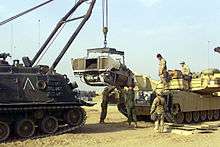
The M88A2 is slightly larger than its predecessors (8.6 x 3.7 x 3.2 m compared to 8.3 x 3.4 x 3.2 m) thus retains a lower top speed (40 km/h) and a significantly lower road range (322 km compared to 450 km). There have also been improvements in braking and steering. Additionally, the M88A2 has upgraded armor protection including armored track skirts and applique armor panels, which both previous models lack. The M88 is also lacking in Nuclear, Biological, Chemical (NBC) defenses and a smoke screen generator, which the later M88A1 and M88A2 models are equipped with. Furthermore, the crew number has decreased from 5, to 3-4, to 3 through the series.[1]
However, all variants retain an M2 Browning .50 caliber machine gun, 432 mm ground clearance, 2.6 m fording depth, 1.1 m wall climb and 2.6 m trench crossing capabilities. There has been no major deviation in battlefield role through the M88 series, the later models are merely able to lift heavier loads. The M88A1 was designed around the now obsolete M60 Patton tanks, so it was in light of the fact that two M88A1's were required to tow the new M1 Abrams tank that the decision was made to upgrade to the M88A2 in 1991.[1]
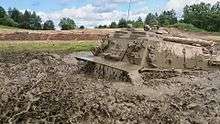
Criticism
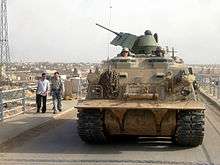
One of the main issues afflicting the current M88A2 is the high rate of winch failures, which is mainly caused by continued winch operation after the cable has wrapped around the drum incorrectly, leading to damaged hub bearings. There is also concern with loss of tractive force when an M88A2 tows a heavy M1 Abrams on a slope in wet, muddy conditions. The M88A2 was extensively tested at the Aberdeen Proving Ground, Maryland and on August 10, 1998 was officially approved for the towing of 70-ton combat vehicles such as the M1 Abrams.[1]
Operators
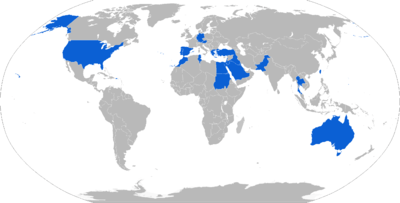

Current operators
 Australia: 7× M88A2 in service with the Australian Army.[3] A request for information on a possible purchase of 6 more valued at $47 million was announced in January 2015.[4]
Australia: 7× M88A2 in service with the Australian Army.[3] A request for information on a possible purchase of 6 more valued at $47 million was announced in January 2015.[4] Austria: 35× M88A1 in service with the Austrian Armed Forces.[3]
Austria: 35× M88A1 in service with the Austrian Armed Forces.[3] Bahrain: 4× M88A1 in service with the Royal Bahraini Army.[3]
Bahrain: 4× M88A1 in service with the Royal Bahraini Army.[3] Brazil: 4x M88A1 in service with the Brazilian Army[5]
Brazil: 4x M88A1 in service with the Brazilian Army[5] Egypt: 221× M88A1 + 87× M88A2 in service with the Egyptian Army.[3]
Egypt: 221× M88A1 + 87× M88A2 in service with the Egyptian Army.[3] Germany: 125× M88A1 (local designation: Bergepanzer 1) in service with the German Army.[3]
Germany: 125× M88A1 (local designation: Bergepanzer 1) in service with the German Army.[3] Greece: 95× M88A1 in service with the Greek Army.[3]
Greece: 95× M88A1 in service with the Greek Army.[3] Iraq: 29× M88A2 in service with the Iraqi Army.[3] Another 8 ordered; to be delivered from late 2013-mid-2014.[6]
Iraq: 29× M88A2 in service with the Iraqi Army.[3] Another 8 ordered; to be delivered from late 2013-mid-2014.[6] Israel: 25× M88A1 in service with the Israeli Army.[3]
Israel: 25× M88A1 in service with the Israeli Army.[3] Jordan: 30× M88A1 in service with the Royal Jordanian Land Force.[3]
Jordan: 30× M88A1 in service with the Royal Jordanian Land Force.[3] Lebanon: 35x M88A1 in service with the Lebanese Armed Forces.[3]
Lebanon: 35x M88A1 in service with the Lebanese Armed Forces.[3] Kuwait: 14× M88A2 in service with the Kuwait Army.[3]
Kuwait: 14× M88A2 in service with the Kuwait Army.[3] Morocco: 12x M88A1 in service with the Royal Moroccan Army [3]
Morocco: 12x M88A1 in service with the Royal Moroccan Army [3] Pakistan: 52× M88A1 in service with the Pakistan Army.[3]
Pakistan: 52× M88A1 in service with the Pakistan Army.[3] Portugal: 6× M88A1 in service with the Portuguese Army.[3]
Portugal: 6× M88A1 in service with the Portuguese Army.[3] Saudi Arabia: 78× M88A1 in service with the Saudi Arabian Army.[3] The potential sale of a further 20 was announced in August 2016.[7]
Saudi Arabia: 78× M88A1 in service with the Saudi Arabian Army.[3] The potential sale of a further 20 was announced in August 2016.[7] Spain: 1× M88A1 in service with the Spanish Navy Marines.[3]
Spain: 1× M88A1 in service with the Spanish Navy Marines.[3] Sudan: 2× M88A1 in service with the Sudan People's Armed Forces.[3]
Sudan: 2× M88A1 in service with the Sudan People's Armed Forces.[3] Republic of China (Taiwan): 37× M88A1 in service with the Republic of China Army.[3]
Republic of China (Taiwan): 37× M88A1 in service with the Republic of China Army.[3] Thailand: 22× M88A1 + 6 M88A2 in service with the Royal Thai Army.[3]
Thailand: 22× M88A1 + 6 M88A2 in service with the Royal Thai Army.[3] Tunisia: 6× M88A1 in service with the Tunisian Armed Forces.[3]
Tunisia: 6× M88A1 in service with the Tunisian Armed Forces.[3] Turkey: 33× M88A1 in service with the Turkish Armed Forces[8][9]
Turkey: 33× M88A1 in service with the Turkish Armed Forces[8][9] United States
United States
- United States Army: total 629 of all variants procured.
- United States Marine Corps: total 69 procured.
See also
Notes
- 1 2 3 4 5 6 7 "M88's info and specs". Federation of American Scientists (FAS). 6 February 2000. Retrieved 24 June 2011.
- ↑ "BAE Systems Awarded $185 Million Contract for M88A2 HERCULES Recovery Vehicles" (Press release). BAE Systems. 2008-03-04. Retrieved 2008-09-11.
- 1 2 3 4 5 6 7 8 9 10 11 12 13 14 15 16 17 18 19 20 "SIPRI arms transfer database". Stockholm International Peace Research Institute. Information generated on 21 June 2011. Retrieved 21 June 2011. Check date values in:
|date=(help) - ↑ "Australia – M88A2 Hercules Heavy Recovery Vehicles" (Press release). Washington, D.C. Defense Security Cooperation Agency. 26 January 2015. Retrieved 4 April 2015.
- ↑ "DefesaNet - Brasil - EUA - Os EUA transferem 50 viaturas blindadas ao EB". defesanet.com.br. Retrieved 15 October 2016.
- ↑ Recovery Vehicles for Iraq - Defense-Aerospace.com, October 8, 2012
- ↑ "Kingdom of Saudi Arabia - M1A2S Saudi Abrams Main Battle Tanks and M88Al/A2 Heavy Equipment Recovery Combat Utility Lift Evacuation System (HERCULES) Armored Recovery Vehicles (ARV)". Defense Security Cooperation Agency. 9 August 2016. Retrieved 19 September 2016.
- ↑ Pike, John. "Turkey - Major Army Equipment". globalsecurity.org. Retrieved 15 October 2016.
- ↑ http://www.armyrecognition.com/turkey_army_turkish_land_forces_modern_military_equipment_armoured_vehicle_._equipements_v_hicules_b.html
References
- Military Vehicles from World War I to the Present - Hans Halberstadt, 1998
- Patton, A History of the American Medium Battle Tank, Vol. 1 - R.P. Hunnicutt, Presidio Press, 1984
External links
| Wikimedia Commons has media related to M88 ARV. |
